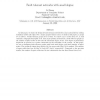Free Online Productivity Tools
i2Speak
i2Symbol
i2OCR
iTex2Img
iWeb2Print
iWeb2Shot
i2Type
iPdf2Split
iPdf2Merge
i2Bopomofo
i2Arabic
i2Style
i2Image
i2PDF
iLatex2Rtf
Sci2ools
SPAA
2000
ACM
2000
ACM
Fault tolerant networks with small degree
In this paper, we study the design of fault tolerant networks for arrays and meshes by adding redundant nodes and edges. For a target graph G (linear array or mesh in this paper), a graph G is called a k-fault-tolerant graph of G if when we remove any k nodes from G , it still contains a subgraph isomorphic to G. The major quality measures for a fault-tolerant graph are the number of spare nodes it uses and the maximum degree it has. The degree is particularly important in practice as it poses constraints on the scalability of the system. In this paper, we aim at designing fault-tolerant graphs with both small degree and small number of spare nodes. The graphs we obtain have degree O(1) for arrays and O(log3 k) for meshes. The number of spare nodes used are O(k log2 k) and O(k2 / log k), respectively. Compared to the previous results, the number of spare nodes used in our construction has one fewer linear factor in k. 1
Distributed And Parallel Computing | Fault-tolerant Graphs | Redundant Nodes | SPAA 2000 | Spare Nodes |
| Added | 01 Aug 2010 |
| Updated | 01 Aug 2010 |
| Type | Conference |
| Year | 2000 |
| Where | SPAA |
| Authors | Li Zhang |
Comments (0)

